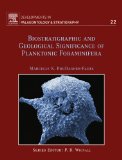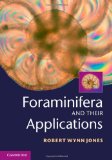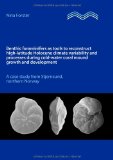Fossil foraminifers
- A core-top calibration of B/Ca in the benthic foraminifers Nuttallides umbonifera and Oridorsalis umbonatus: A proxy for Cenozoic bottom water carbonate saturation

- A Late Cretaceous flysch-type agglutinated foraminiferal fauna from the Trochamminoides proteus type locality (Wien - Hiitteldorf, Austria)

- A Monograph of the Foraminiferal Family Nonionidae

- A new high-resolution planktic foraminiferal zonation and subzonation for the lower Danian

- A Nyugati-Thethys egyes paleogén nagyforaminiferáinak morfometriai analízisre alapozott rétegtani jelentősége

- Abiotic forcing of plankton evolution in the Cenozoic

- Agglutinated foraminifera from neritic to bathyal facies in the Palaeogene of Spitsbergen and the Barents Sea

- Agglutinated foraminifera from the Northern Tarcău Nappe (Eastern Carpathians, Romania)

- Agglutinated Middle-Upper Eocene foraminifera in Jabal Hafit, Al Ain area, United Arab Emirates

- Atlas of Paleocene Planktonic Foraminifera

- Atlas of Paleogene Cosmopolitan Deep Water Agglutinated Foraminifera
- Badenian Pappinidae and Uvigerinidae from the South-western margin of the Pannonian Basin (Eastern Slovenia)

- Bathysiphons From the Eocene of the Carpathian Flysch, Poland

- Benthic foraminifera and environmental turnover across the Cretaceous/Paleogene boundary at Blake Nose (ODP Hole 1049C, Northwestern Atlantic)

- Benthic foraminifera at the Cretaceous-Tertiary boundary around the Gulf of Mexico

- Benthic foraminifera, microfacies analysis and paleoenvironmental interpretations of Early Eocene shallow water carbonates from Sahlabad province, eastern Iran

- Benthic foraminifera and environmental turnover across the Cretaceous/Paleogene boundary at Blake Nose (ODP Hole 1049C, Northwestern Atlantic)

- Benthic foraminiferal faunal turnover across the Cretaceous/Tertiary Boundary at Agost (Southeastern Spain)

- Benthonic Foraminiferal Biostratigraphy of the Upper Cretaceous (Middle Cenomanian−Coniacian) Sequences of the Bey Dağları Carbonate Platform, Western Taurides, Turkey

- Bioerosive structures in orbitolinid foraminifera: examples from the Lower Cretaceous of Central Iran

- Biostratigraphical and paleoecological significance of small foraminiferal assemblages of the Silesian (Cieszyn) Unit, Western Carpathians, Poland

- Biostratigraphy and evolutionary trends of Late Paleocene-Early Eocene planktic Foraminifera at West Central Sinai, Egypt

- Biostratigraphy and paleoenvironmental analysis of benthic foraminifera and radiolarians in Paleogene Variegated Shales in the Skole Unit, Polish Flysch Carpathians

- Biostratigraphy and stepwise extinctions of the larger foraminifera during Cenomanian (Upper Cretaceous) of Gebel Um Horeiba (Mittla Pass), west-central Sinai, Egypt

- Biostratigraphy and Systematic Description of Benthic Foraminifers from Mid-Cretaceous Shallow-Water Carbonate Platform Sediments at Sites 878 and 879 (Mit and Takuyo-Daisan Guyots)

- Biostratigraphy of Albian to Turonian deep-water agglutinated foraminifera calibrated by planktonic foraminifera, Radiolaria, and dinoflagellate cysts in the Pieniny Klippen Belt, Polish Carpathians

- Cenomanian to Lower Eocene deep-water agglutinated Foraminifera from the Zumaya Section, Northern Spain

- Cenozoic Record of Elongate, Cylindrical, Deep-Sea Benthic Foraminifera in the Indian Ocean (ODP Sites 722, 738, 744, 758 and 763)

- Cenozoic record of elongate, cylindrical deep-sea benthic Foraminifera in the North Atlantic and equatorial Pacific Oceans

- Chattian Larger Foraminifera, northern Sinai, Egypt, and paleogeographic interpretations

- Climate Analysis Using Planktonic Foraminifera
- Coiling modes in the Family Plectorecurvoididae (Foraminiferida)

- Collection and Mounting of Foraminifera
- Contributions to the knowledge of the rotaliiform foraminifera from the marine Middle Miocene deposits from Romania

- Cretaceous/Paleogene boundary bathyal paleo-environments in the central North Pacific (DSDP Site 465), the Northwestern Atlantic (ODP Site 1049), the Gulf of Mexico and the Tethys: The benthic foraminiferal record

- Cretaceous evolution of the genus Adercotryma (Foraminifera) in the deep Pacific

- Cretaceous to Paleogene agglutinated foraminifera of the BilC Karpaty Unit (West Carpathians, Czech Republic)

- Cushman Foundation for Foraminiferal Research
- Danian and Selandian calcareous benthic foraminiferal assemblages and biostratigraphy of Western Siberia
- Details of Uvigerina development in the Cretan Mio-Pliocene
- Discovery Of The Lower Murgabian (middle Permian) Based On Neoschwagerinids And Verbeekinids In The Taurides, Southern Turkey

- Duostominidae (Foraminiferea, Robertinida) from the Upper Triassic beds of the Slovenian Basin (Southern Alps, Slovenia)

- Early and Middle Triassic trends in diversity, evenness, and size of foraminifers on a carbonate platform in south China: implications for tempo and mode of biotic recovery from the end-Permian mass extinction

- Early Aptian Benthic Foraminifera from Cajon Formation, Huetamo, Michoacan, SW Mexico

- Early Cenozoic benthic foraminiferal isotopes: species reliability and interspecies correction factors

- Early Miocene foraminifers from the Upper Marine Molasse of the North Alpine Foreland Basin – Proxies for biostratigraphy and palaeoenvironmental change

- Early Oligocene Foraminifera from Kap Brewster, East Greenland

- Early Oligocene Larger Foraminiferal Biostratigraphy of the Qom Formation, South of Uromieh (NW Iran)

- Early Paleogene planktic foraminiferal biostratigraphy at the Monastery of Saint Paul, Southern Galala, Eastern Desert, Egypt

- Early to middle Miocene foraminifera from the deep-sea Congo Fan, offshore Angola

- Enigma of early Miocene biserial planktic foraminifera

- Eocene-Oligocene planktic foraminiferal transition: extinction, impact and hiatuses

- Eocene Benthic Foraminifers from the Western North Atlantic, Site 1276, ODP Leg 210

- Evolution and molecular phylogeny of Cibicides and Uvigerina (Rotaliida, Foraminifera)
- Evolution of early Foraminifera

- Evolutionary aspects of the Miogypsinids in the Oligo-Miocene carbonates near Mineo (Sicily)
- Evolutionary history of size variation of planktic foraminiferal assemblages in the Cenozoic

- Evolutionary trends and stratigraphic significance of the late Cretaceous Helicorbitoides-Lepidorbitoides lineage
- Experiments to determine the origin and palaeoenvironmental significance of agglutinated foraminiferal assemblages

- Extinction and food at the sea floor: a high-resolution benthic foraminiferal record across the Initial Eocene Thermal Maximum, Southern Ocean Site 690

- Extinction Patterns and Paleoenvironments of the Middle Cenomanian-Early Turonian Foraminifers at the Southern Galala Plateau, Eastern Desert, Egypt

- Factors controlling the distribution of agglutinated foraminifera in Aalenian-Bajocian dysoxic facies (Pieniny Klippen Belt, Poland)

- Faunal dynamics of foraminiferal assemblages in the Bathonian (Middle Jurassic) ore-bearing clays at Gnaszyn, Kraków-Silesia Homocline, Poland

- Fluid Rocking of a Suspension of Foraminifera as a means of Concentrating Samples for the Preparation of Strews
- “Flysch-type” agglutinated foraminifera from the Lower Miocene of the Transylvanian Basin (Romania)

- Foram Facts - An Introduction To Foraminifera
- Foraminifera
- Foraminifera - National Museum of Natural History
- Foraminifera
- Foraminifera
- Foraminifera and microfacies of the type-Priabonian
- Foraminifera and petroleum exploration: case studies from carbonate and clastic systems

- Foraminifera and sequence stratigraphy of the lower part of the Speeton Clay Formation (Lower Cretaceous) in N. E. England

- Foraminifera as environmental proxies of the Middle Miocene (Early Badenian) sediments of the Central Depression (Central Paratethys, Moravian part of the Carpathian Foredeep)

- Foraminifera assemblages in the eastern part of the Stetten-section from the Karpatian of the Korneuburg Basin

- Foraminifera Biostratigraphy and Paleoenvironmental Studies of Two Wells from Offshore Western Niger Delta

- Foraminifera from the Eocene Variegated Shales near Barwinek (Magura Unit, Outer Carpathians), the type locality of Noth (1912) revisited

- Foraminifera from the Late Jurassic and Early Cretaceous carbonate platform facies of the southern part of the Crimea Mountains, Southern Ukraine

- Foraminifera in the Middle School Classroom
- Foraminifera.eu-Project
- Foraminiferal assemblage-based biostratigraphy and correlation of the Triassic of northern Israel

- Foraminiferal assemblages as palaeoenvironmental bioindicators in Late Jurassic epicontinental platforms: Relation with trophic conditions

- Foraminiferal Biostratigraphy and Palaeoenvironmental Reconstruction of the Paleocene–Eocene Transition at the Kharrouba Section, Tunisia (Southern Tethys Margin)

- Foraminiferal biostratigraphy of the Egerian flysch sediments in the Silesian Nappe, Outer Carpathians, Polish part of the Bieszczady Mountains

- Foraminiferal biostratigraphy of the Polish Outer Carpathians: a record of basin geohistory

- Foraminiferal description and biostratigraphy of the Oligocene shallow marine sediments in Denizli region, SW Turkey

- Foraminiferal palaeodepth indicators from the lower Palaeogene deposits of the Subsilesian Unit (Polish Outer Carpathians)

- Foraminiferal Record of the Onset of the Middle Miocene Badenian Salinity Crisis in Central Paratethys

- Foraminiferal Research at Byrd Polar Research Center
- Foraminiferal suborder Robertinina from the Badenian of Kozjansko (Eastern Slovenia)

- Foraminiferal successions in the shallow water Sarmatian sediments from the MZ 93 borehole (Vienna Basin, Slovak part)

- Foraminiferal survivors from the Permian-Triassic mass extinction in the Meishan section, South China

- Foraminiferos
- Foraminifers And Biostratigraphy Of Upper Triassic And Lower Jurassic Of The Slovakian And Polish Carpathians

- FORAMS 2010 - International Symposium on Foraminifera (September 5th-10th, 2010, Bonn, Germany)
- Fusulinoidean Faunas From The Upper Carboniferous And Lower Permian Platform Limestone In The Hadim Area, Central Taurides, Turkey

- Globorotaliid intervals of the sub-evaporite Badenian (Middle Miocene) in the Upper Silesia Basin (Central Paratethys, Poland)

- Growth Rate Biometric Quantification by X-ray Microtomography on Larger Benthic Foraminifera: Three-dimensional Measurements Push Nummulitids into the Fourth Dimension

- Growth-invariant Meristic Characters Tools to Reveal Phylogenetic Relationships in Nummulitidae (Foraminifera)

- High-Resolution Benthic Foraminiferal Stable Isotope Stratigraphy across the Oligocene/Miocene Boundary at Site 1218

- High resolution biostratigraphy based on planktic foraminifera across the Cretaceous–Paleogene transition at the Bidart section (SWFrance)

- High-resolution deep-water agglutinated foraminiferal record across the Paleocene/Eocene transition in the Contessa Road section (Central Italy)

- High resolution planktic foraminiferal biostratigraphy and correlation across the Paleocene/Eocene boundary in the Tethys

- High resolution Single Particle Analysis by scanning electron microscopy: A new tool to investigate the mineral composition of agglutinated foraminifers

- Ian Boomer Gallery of Recent British Intertidal Foraminifers and Ostracodes
- Indian Ocean high-productivity event (10–8 Ma): Linked to global cooling or to the initiation of the Indian monsoons?

- Inferring Ancient Environments From Fossil Foraminifera
- Integrated Oligocene−Lower Miocene Larger and Planktonic Foraminiferal Biostratigraphy of the Kahramanmaraş Basin (Southern Anatolia, Turkey)

- Integrating Microfossil Records from the Oceans and Epicontinental Seas

- International Symposium on Foraminifera FORAMS 2014 Abstract Volume

- Introduction to the Foraminifera
- Introduzione ai foraminiferi
- Jurassic planktonic foraminifera from Pieniny Klippen Belt and their taxonomic and phylogenetic importance (Carpathians, southern Poland)

- Langer Lab - Foraminifera
- Larger benthic Foraminifera of the type Maastrichtian

- Larger foraminifera from the Early Eocene of Shabwa area, Southeastern Yemen

- Larger foraminiferal turnover during the Paleocene/Eocene thermal maximum and paleoclimatic control on the evolution of platform ecosystems

- Late Cretaceous-Early Eocene benthic foraminifera from Esh El Mallaha area, Egypt

- Late Eocene evolution of nummulitid foraminifer Spiroclypeus in the Western Tethys

- Late Eocene to Recent Deep-Sea Benthic Foraminifers From the Central Equatorial Pacific Ocean

- Late Jurassic–Early Cretaceous Foraminifera from Štramberk-type Limestones, Polish Outer Carpathians

- Late Maastrichtian-Early Danian serial planktic foraminifera as indicators of paleoecology at West Central Sinai, Egypt

- Late Maastrichtian-Late Palaeocene planktic foraminiferal biostratigraphy of the matrix of the Bornova Flysch Zone around Bornova (İzmir, Western Anatolia, Turkey)

- Late Maastrichtian foraminiferids and diatoms from the Polish Carpathians (Ropianka Formation, Skole Nappe): a case study from the Chmielnik-Grabówka composite section

- Late Oligocene Foraminifera from the Krosno Beds in the San valley section (Bieszczady Mountains); Silesian Unit, Polish Outer Carpathians

- Lower Cretaceous Calcareous Agglutinated Foraminifera from Southern Dobrogea, Romania. Part II. Early Cretaceous Cuneolinidae

- Lower Cretaceous agglutinated Foraminifera from the Superfamilies Verneuilinacea and Ataxophragmiacea; southern Dobrogea, Romania

- Maastrichtian small benthic foraminifera from Middle East and their distribution in the Tethys

- Mass extinction in planktic foraminifera at the Cretaceous/Tertiary boundary in subtropical and temperate latitudes

- Mediterranean pliocene globorotalia : a biometrical approach
- Mexican Foraminifera
- Microdistribution of Foraminifera in a Single Bed of the Monterey Formation, Monterey County, California

- Microfaunal Diversity And Diagenesis In The Muschelkalk Facies

- Middle-late Miocene benthic foraminifera in a western Indian Ocean Depth Transect: paleoceanographic implications

- Middle and Late Cretaceous planktonic foraminifera of the Western Mediterranean area
- Middle and Late Eocene benthic foraminiferal fauna from the Hungarian Paleogene Basin: systematics and paleoecology

- Middle Miocene (Early Badenian) Amphistegina (Foraminiferida) from Olimpów (Central Paratethys, Poland)

- Middle Miocene Foraminiferal Biochronology And Ecology of SE Poland

- Middle Miocene Globigerinas of Romania

- Middle to late Eocene evolution of nummulitid foraminifer Heterostegina in the Western Tethys

- Middle Triassic Foraminifera From The Seceda Core (Dolomites, Northern Italy)

- Miocene deep-water agglutinated foraminifera from the Lomonosov Ridge and the opening of the Fram Strait

- Miocene deep water agglutinated foraminifera from Viosca Knoll, offshore Louisiana (Gulf of Mexico)

- Most abundant Middle Miocene rotaliinas (suborder Rotaliina, Foraminifera) of Kozjansko (Eastern Slovenia)

- National Collection of Foraminifera
- Neogene Foraminiferal zones
- New advances in understanding the heterohelicid planktic foraminifer early evolution

- New data to suport the phylogenetic relationship between the serial planktonic foraminifera (Family Heterohelicidae CUSCHMAN, 1927) and some large-sized benthic foraminifera (Family Orbitoididae SCHWAGER, 1876) of the Late Cretaceous

- New Late Ypresian (Cuisian) rotaliids (Foraminiferida) from Central and Southern Italy and their biostratigraphic potential

- New Zealand Neogene-Recent Foraminifera with A guide to some Bolivinita (Foraminiferida) in the New Zealand Late Neogene
- North Sea Lituolid Foraminifera with complex inner structures: taxonomy, stratigraphy and evolutionary relationships

- Oligocene Benthic Foraminifers from the Eastern Equatorial Pacific, Sites 1218 and 1219, ODP Leg 199

- Oligocene Paleoceanography of the Equatorial Pacific Ocean: Planktonic and Benthic Foraminifer Stable Isotope Results from Site 1218

- On the systematics of rugoglobigerinids (planktonic Foraminifera, Late Cretaceous)

- Ontogenetic Morphometrics of Some Late Cretaceous Trochospiral Planktonic Foraminifera from the Austral Realm

- Orbitolinid foraminifers in the Northwest Pacific: Their taxonomy and stratigraphy

- Origin, evolutionary classification, and biostratigraphic significance of the Late Cretaceous planktic foraminiferal directional lineage Bollitruncana O.A. Korchagin, 2001

- Paleoceanographical proxies based on deep-sea benthic foraminiferal assemblage characteristics

- Paleocene/Eocene Benthic Foraminifers, ODP Leg 199 Sites 1215, 1220, and 1221, Equatorial Central Pacific Ocean

- Paleoecology of late miocene mediterranean foraminifera
- Paleogene Dictionary
- Paleontology and stratigraphic distribution of suborder Lagenina (benthic foraminifera) from the Middle-Late Eocene Mazyad Member of the Dammam Formation in Jabal Hafit, Al Ain area, United Arab Emirates, Northern Oman Mountains

- Paleontology, paleobathymetry, paleoecology, paleogeography and stratigraphic distribution of the Rotaliina (benthic foraminifera) from the Middle-Late Eocene Mazyad Member of the Dammam Formation in Jabal Hafit, Al Ain area, United Arab Emirates, Northern Oman Mountains

- Paleozoogeographic regionalisation of Northern Hemisphere Late Cretaceous Basins based on Foraminifera

- Patterns of spatio-temporal distribution as criteria for the separation of planktic foraminiferal species across the Danian-Selandian transition in Spain

- Permian non-fusuline foraminifers of the Akasaka Limestone (Japan)

- Phanerozoic diversity of agglutinated foraminifera: Origination and extinction rates

- Planktic foraminiferal dissolution in the twilight zone

- Planktonic foraminiferal biostratigraphy of the late Neogene of Crete (Greece)
- Planktonic foraminiferal response to Middle Miocene cooling in the Southern Ocean (ODP Site 747, Kerguelen Plateau)

- Planktonic foraminifers, biostratigraphy and the diachronous nature of the lowermost Danian Cerithium Limestone at Stevns Klint, Denmark

- Plankrange - A Database of Planktonic Foraminiferal Ranges
- Pliocene-Pleistocene Foraminiferal Assemblages of the Middle and Lower Tiber Valley: Stratigraphy and Paleoecology

- Polymerization and oligomerization in foraminiferal evolution

- Preparation Techniques For Use Of Foraminifera In the Classroom
- Quaternary Calcareous Benthic Foraminifers, Leg 80

- Response of planktic foraminiferal size to late Quaternary climate change

- Role of the Palaeogene Adriatic Carbonate Platform in the Spatial Distribution of Alveolinids

- Sarmatian foraminifera fauna from Budapest (Hungary)

- Saudi Arabian Late Jurassic and Early Cretaceous agglutinated foraminiferal associations and their application for age, palaeoenvironlnental interpretation, sequence stratigraphy, and carbonate reservoir architecture

- Sea-floor distribution and Late Quaternary faunal patterns of planktonic and benthic foraminifers in the Angola Basin
- SEPM Strata - Foraminifera
- Short Treatise on Foraminiferology (Essential on modern and fossil Foraminifera)

- Size distribution of Holocene planktic foraminifer assemblages: biogeography, ecology and adaptation

- Smaller agglutinated foraminifera from the Achanticum Limestone (Upper Jurassic), Eastern Carpathians- Romania

- Smithsonian foraminifera
- Spatial Distribution of Miocene Foraminifera at Calvert Cliffs, Maryland

- Stable Isotope Ratios of Foraminifers from ODP Leg 207 Sites 1257, 1258, and 1260 and a Cleaning Procedure for Foraminifers in Organic-Rich Shales

- Stratigraphic distribution of the Middle Jurassic foraminifera in the Middle East

- Stratigraphic Record of the Neogene Globorotalid Radiation (Planktonic Foraminiferida)

- Stratigraphy and Palaeobiogeography of Mesozoic Benthic Foraminifera of the Karst Dinarides (SE Europe)

- Stratigraphy of Neogene deposits in the Khania province, Crete, with special reference to foraminifera of the family Planorbulinidae and the genus Heterostegina
- Stratigraphy of Neogene deposits in the Rethymnon Province, Crete, with special reference to the phylogeny of uniserial Uvigerina from the Mediterranean region
- Systematics and biostratigraphic notes of the upper Moscovian-upper Gzhelian fusulinid foraminifers from the Anatolian Platform in the Southern Turkey

- Taxonomic diversity of foraminifers of the Devonian-Carboniferous boundary interval in the South Urals

- Taxonomy, nomenclature, and evolution of the early schubertellid fusulinids

- Taxonomy and Paleoecology of Early Miocene Benthic Foraminifera of Northern New Zealand and the North Tasman Sea

- Test structure and classification in agglutinated foraminifera

- Thanetian And Early Ypresian Orthophragmines (Foraminifera: Discocyclinidae And Orbitoclypeidae) From The Central Western Tethys (Turkey, Italy And Bulgaria) And Their Revised Taxonomy And Biostratigraphy

- Triassic Foraminifers From Sites 761 And 764, Wombat Plateau, Northwest Australia

- Tubular agglutinated foraminifera as indicators of organic carbon flux

- Type Register
- Two Species Of Profusulinella (p. Aljutovica And P. Ovata), Early Moscovian (Pennsylvanian) Fusulines From Southern Turkey And Subdivision Of Primitive Groups Of The Family Fusulinidae

- Upper Barremian-Lowermost Aptian Orbitolinid Foraminifers from the Grand Banks Continental Rise, Northwestern Atlantic (Dsdp Leg 43, Site 384)

- Upper Cretaceous and lower Paleogene benthic Foraminifera from northeastern Mexico

- Upper Miocene planktonic foraminifera from Algarve. Chronostratigraphical implications

- Use of multivariate statistics to determine the paleoenvironmental distribution of Lower Carboniferous Foraminifera from Ireland

- Utility of Deep-Water Agglutinated Foraminiferal acmes for correlating Eocene to Oligocene abyssal sediments in the North Atlantic and Western Tethys

- Year 2000 classification of the agglutinated foraminifera

Books about foraminifera


